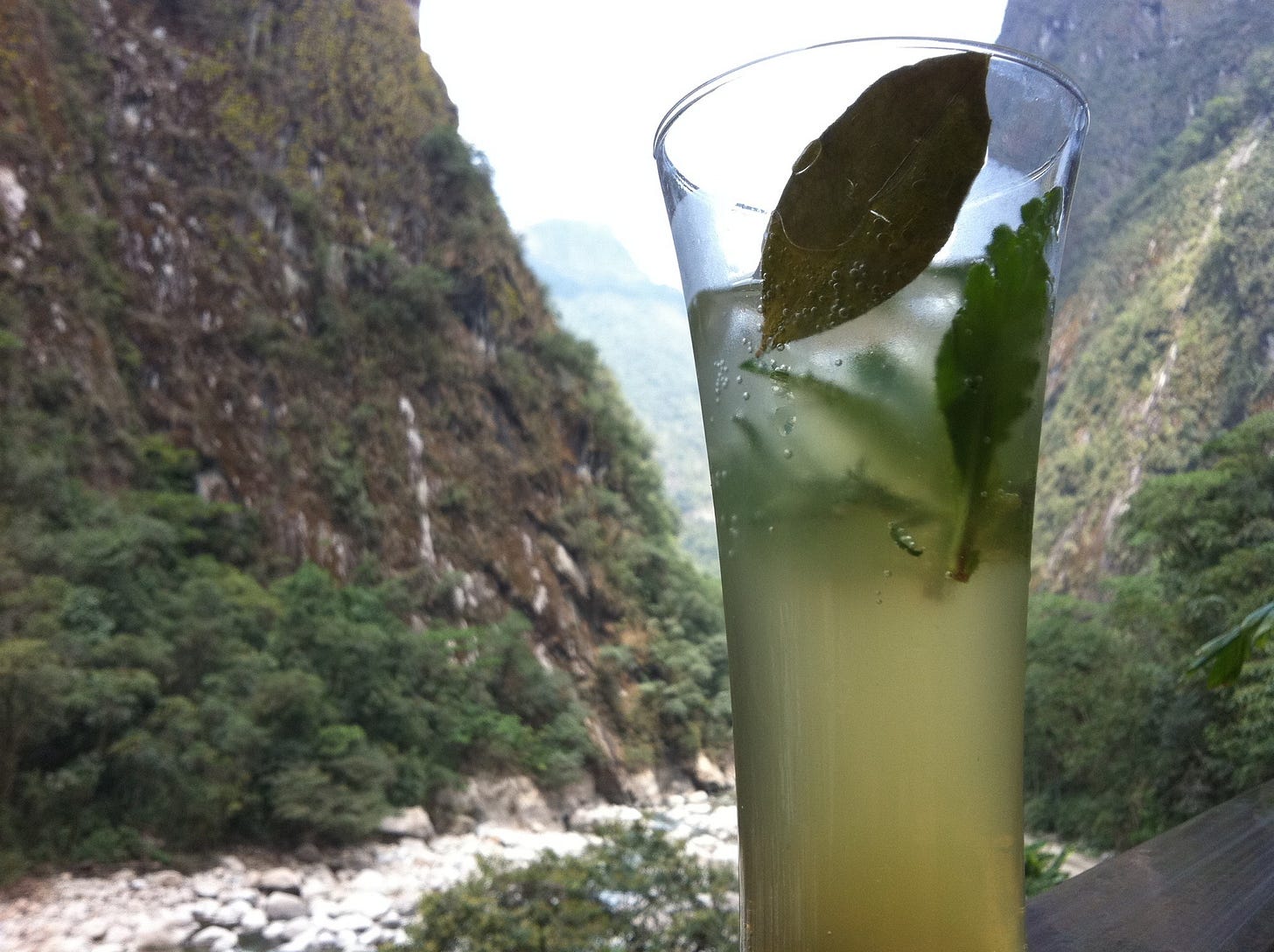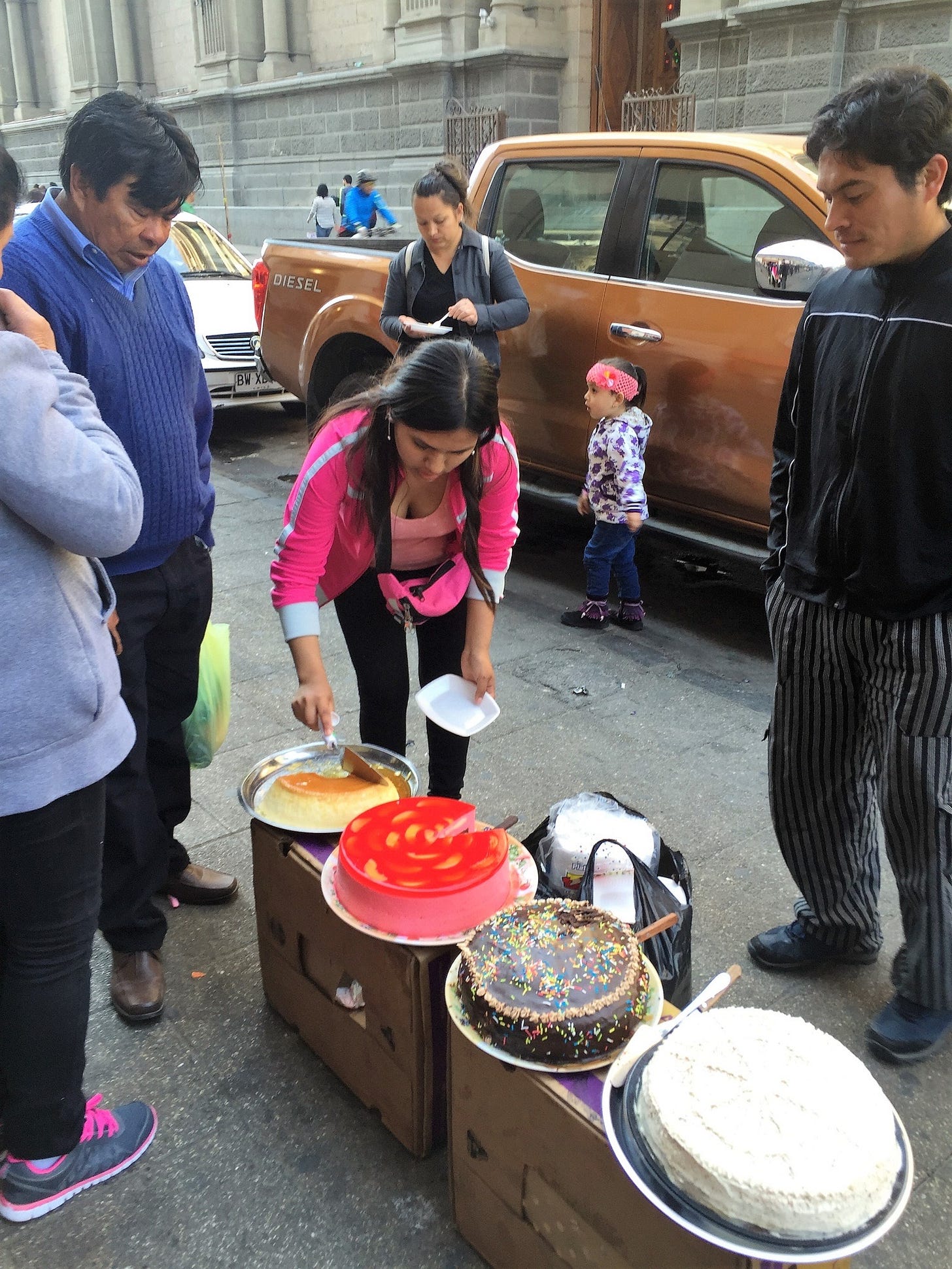Why Is The Food Bad In South America?
Is it the Spanish Empire, plus the Portuguese? - but then why not the British?
Cheers: a “coca sour” in a little hotel on the road to Macchu Picchu; it was *reviving*
Apologies for not posting in AEONS. I have been finishing a novel and bestriding continents. Well, kinda. Also faffing about with AI, going to Gulags, meeting genocide survivors, and admiring the Tomb of Tamerlane. More later. Until then, here is the Big Question:
Why Did the Spanish Leave Behind Such Terrible Food?
I can still remember it: probably the worst seafood dinner of my life. A slice of fish that was simultaneously cold, hot, dry, crumbly, rubbery, and surrounded by overcooked vegetables with a whiff of cigarette smoke. It was so repellent, even though I was famished, I summoned the waiter, returned the dish, and retired to my room, there to endure a dinner of Pringles from the minibar.
What made it worse was this was in a celebrated fishing port. All I had to do was look out of the window and I could see the trawlers, bringing in some of the world's finest fish from some of the planet’s richest seas. It was dismaying, saddening, deflating, and left me starving, but what it was not, however, was surprising. Because I was on the coast of Chile, and - as a travel writer - I have long grown used to a peculiar truth of worldwide food. With some notable exceptions, wherever the Spanish had a colony, the cuisine they left behind is mediocre, or worse.
I'm talking mainly, of course, about central and south America. I am still mentally scarred by some of the awful meals I've had across LatAm. A pizza in Havana Cuba that was basically undercooked dough, dotted with splodges of rancid lard - and nothing else. Naturally, you could blame this on the privations of life in Cuba, the embargoes and the communism, but then the only pizza I've had that rivals this for inedibility was in Iquitos in Peru, where the dough was uncannily similar, and the lard-splodges were replaced, it seemed, by river-toad. My meal partner nearly threw up.
The list goes on. The Uruguayans are Argentinians do a wonderful steak (try Restaurant Garzon, Garzon, Uruguay), and the high-altitude Argentine Malbecs are sensational, but that's largely where it stops. Everything else is generally fried, overfried - or bland, insipid, repetitive.
At the other end of the continent, ultra-fertile, super-verdant, sunny and tropical Colombia is easily as bad. Sure, if you love fruit you're in heaven, Colombia has the finest fruit in the world, including exotic varieties of citrus filled apparently with ambrosia, but unless you're a dedicated fruitarian, at some point you will want more than soursop, and then Colombia disappoints. In four weeks across Colombia the best meal I had, in all honesty, was a rather decent burger. And what's with the chewy fried plantains and rice? Who wants two carbs?
A selection of Peruvian chocolate, at least the wrappers are lovely
The obvious argument, of course, is that this is not a Spanish thing, but a Latin American thing (Brazilian food is quite bad, too). But this is where I present, M’Lud, Evidence B: the Philippines, the one major Spanish colony in Asia. Given its favourable, tropical geographical location, the Philippines should have wonderful food, because all the southeast Asian countries surrounding the Philippines - Malaysia, Indonesia, Thailand, China - have wonderful food.
But food in the Philippines generally means something soused with fat, doused with sugar, envenomed with salt, and with a fried egg on top. It's not only dreary, it's properly unhealthy. Note that in nearby Vietnam 3% of adults are obese; in the Philippines it is 21%.
So there is definitely a theme, which needs explaining. One explanation that doesn't work is the relative complexity and sophistication of the imperializing cuisine. France, with its noble culinary traditions, often left behind brilliant foods that the colonized locals have adapted: in Vietnam the banh mi ("the best sandwich in the world" - Anthony Bourdain) is a magnificent collision between the baguette and umami-rich Asian fillings. You can also find brilliant Franco-Asian foods in Cambodia (Phnom Penh is becoming a grand foodie capital), and, if you're lucky, excellent Franco-North African fusions in Morocco.
However the British, who were definitely not known for their native cuisine, especially at the time of peak empire building (happily British food has improved since) managed, firstly, not to destroy the cuisine of the gastronomically-endowed places they colonized -- eg India, Hong Kong, Malaysia. And, secondly, the meeting of British and non-British cultures sometimes created fine dishes by itself: from mulligatawny to kedgeree to chicken tikka masala. The very word “curry” is British in origin (there is no such Indian word). Also, the Imperial Raj gave us the world’s greatest cocktail, in the Gin and Tonic (and God Save the King for that).
Street cakes for sale in Santiago, Chile. Those colours!
And so we loop back to the Spanish question. Metropolitan Spain has a glorious cuisine, from the seafoods of Galicia to the tapas of Andalucia. Yet none of this culinary excellence transferred to its imperial possessions, instead they mainly got rice and beans. Why? Is it because Spanish colonialism was uniquely brutal, erasing food cultures? Was it the encomienda system of farming, laying waste to local agriculture? Again, these arguments can all be countered with the peculiar outlier of the Philippines.
Perhaps a partial answer can be found in the few Spanish possessions which were not gastro-imperially devastated. And these are the colonies that already had a strong civilization before the arrival of the Conquistadors. Eg once-Incan Peru can still do some impressive things with the native potato, and intriguing things with raw fish (ceviche) but mainly we are talking about Mexico, with its proud Mesoamerican history. Anyone who has travelled across Mexico will know that, despite the efforts of Cortes, it has one of the world's noblest, most diverse cuisines: it isn’t just tacos and tortillas.
From extraordinary pozoles to chocolate-sauce moles, Mexican cuisine survived the Spanish onslaught and emerged with its native foodie flair unsullied, and it really is pre-Colombian food we are talking about. The word chocolate itself derives from the Aztec/Nahuatl: xocolatl. When you eat anything chocolate you are eating a food once reserved for the emperors in Tenochtitlan, sitting on top of their pyramids, ritually piercing their penises every morning with cactus thorns, to appease the angry sun gods. It sheds a whole new light on Hershey’s Kisses and Cadbury’s Roses.
That then, is the best I can do, as a world traveller, in answer to this conundrum. There is no one good, single, answer to why the Spanish left behind such disappointing tucker, but there is a lesson. If you must be colonized by the Spanish, make sure you have some of your own recipes, beforehand. And ask for something decent in exchange for all those lovely tomatoes, avocados and chili peppers.
OK, it’s not all bad. This was the best steak of my life, and I had it about two weeks ago, in Restaurant Garzon, Garzon, Uruguay. Admire that layer of glistening fat!









Just done a month in Argentina. Defaulted to burgers after a week. Steaks are samey as hell. Tierra del fuego has spider crabs and black hake, unexcitingly prepared. Guanaco stew is the local delicacy but nothing about them says "eat me" to me.
This is a very hot take. You do admit that Peru does some good stuff and yes to Mexico. I have been all over the country and regularly had my socks knocked off at the humblest of venues. As an old Asia salt I also concur about the largely dire state of Filipino food, though their take on ceviche (kiliwan?) is out of this world. Just stay away from the fermented sea worm, balut, and the ubiquituous chicken cordon bleu.